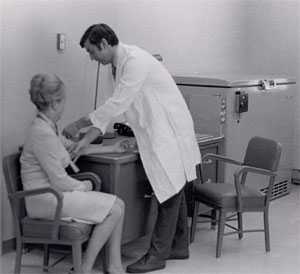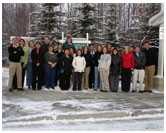AIP Has a Rich History and Traces Its Origins Before Alaska's Statehood
1948 – 1967
Congress established the Arctic Health Research Center (AHRC) in Anchorage as part of the U.S. Public Heath Service. Collaborative studies between the AHRC and Alaska Native Medical Center were conducted on biology and health in the Arctic, including the early treatment and prevention of tuberculosis. The AHRC also conducted studies in virology, parasitology, environmental health, entomology, and epidemiology.
1968 – 1972
The Arctic Health Research Center laboratory moved to Fairbanks. The epidemiology unit stayed in Anchorage to retain the close association with the staff of the Alaska Native Medical Center. Collaborative studies were conducted on a variety of infectious and non-infectious diseases of significance in the Alaska Native people such as mumps, pneumonia, cardiovascular diseases, hereditary diseases, cystic echinococcosis, and anemia.
1973 – 1979
The Arctic Health Research Center closed. The epidemiology activities in Anchorage were adopted by CDC, which established a laboratory on the Alaska Native Medical Center grounds. The unit became known as the Alaska Investigations Program. Collaborative studies continued in the areas of infant mortality and infectious diseases of children, such as streptococcal disease and rheumatic fever. A prevention program for streptococcal disease was established. Studies continued on the causes of meningitis and anemia, effects of otitis media, hepatitis, genetic and metabolic disorders, epidemiology of cancer, and foodborne botulism.
1980 – 1988
Vaccine evaluations for prevention of infections caused by Haemophilus influenzae type b and hepatitis B virus were begun. The natural history of hepatitis B was described. The association between hepatitis B and liver cancer and between the Epstein-Barr virus and nasopharyngeal cancer were described. An early screening program for the detection and treatment of alveolar hydatid diseases was begun, and efforts to determine the factors causing iron deficiency anemia in rural Alaska were resumed. Botulism surveillance and outbreak responses for Alaska were an AIP responsibility.
1989 – 1992
Collaborations between AIP, Indian Health Service, and the State of Alaska resulted in statewide vaccine programs for the prevention of hepatitis B and Haemophilus influenzae type b infections. These programs resulted in a dramatic statewide reduction in diseases caused by these infections. Vaccine evaluations for the prevention of pneumococcal disease were initiated. Studies on the association between human papillomavirus and cervical cancer were conducted.
1993 – 1996
Vaccine programs for the control of hepatitis A in Alaska Natives were initiated, along with studies to define the extent of hepatitis C in Alaska Natives. Studies on the etiology of iron deficiency in Alaska Natives focused on blood loss and a possible role of Helicobacter pylori infection. Dramatic outbreaks of acute respiratory diseases in Alaska Native infants led to surveillance for hospitalizations due to respiratory syncytial virus and evaluation of possible prevention and control strategies.
1997 – Present
The new Alaska Native Medical Center and Arctic Investigations Program buildings were completed. Priority activities include prevention of diseases caused by Streptococcus pneumoniae, Haemophilus influenzae type b, Helicobacter pylori, methicillin-resistant Staphylococcus aureus, and respiratory syncytial virus (RSV), and control of viral hepatitis. In 1998, AIP started the International Circumpolar Surveillance Network to link public health laboratories across the circumpolar North. The network includes ongoing shared surveillance with the US, Canada, Greenland, Iceland, Norway, Sweden and Finland. New higher containment laboratory space was added as AIP joined the nationwide Laboratory Response Network in 2001. AIP staff were deployed to assist with national emergencies and outbreaks including the 2001 Anthrax attacks, the 2003 SARS outbreak, hurricane response and the 2009 influenza pandemic. In 2010, the laboratory was renovated to improve research and response capacity, worker safety and training capabilities.

Exam room in early AIP building.

Examination in the old AIP building.

Old AIP building.

Current AIP building.

AIP staff.

Moose in front of CDC-AIP sign.
- Page last reviewed: April 1, 2011
- Page last updated: April 1, 2011
- Content source:


 ShareCompartir
ShareCompartir